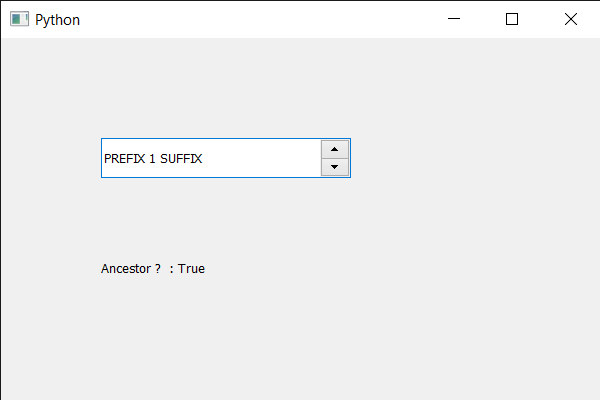En este artículo veremos cómo podemos verificar si el cuadro de número es el antepasado del niño dado. Si el cuadro de número es un padre (o abuelo, etc. en cualquier nivel), del niño dado, y tanto el cuadro de número como el niño están dentro de la misma ventana, entonces es cierto que es un antepasado; de lo contrario, no lo es.
Para hacer esto, usamos isAncestorOfel método con el objeto de cuadro de número.
Sintaxis: spin_box.isAncestorOf(hijo)
Argumento: Toma el argumento del objeto QWidget
Return : Devuelve bool
A continuación se muestra la implementación.
# importing libraries
from PyQt5.QtWidgets import *
from PyQt5 import QtCore, QtGui
from PyQt5.QtGui import *
from PyQt5.QtCore import *
import sys
class Window(QMainWindow):
def __init__(self):
super().__init__()
# setting title
self.setWindowTitle("Python ")
# setting geometry
self.setGeometry(100, 100, 600, 400)
# calling method
self.UiComponents()
# showing all the widgets
self.show()
# method for widgets
def UiComponents(self):
# creating spin box
self.spin = QSpinBox(self)
# setting geometry to spin box
self.spin.setGeometry(100, 100, 250, 40)
# setting range to the spin box
self.spin.setRange(1, 999999)
# setting prefix to spin
self.spin.setPrefix("PREFIX ")
# setting suffix to spin
self.spin.setSuffix(" SUFFIX")
# getting child of spin box
child = self.spin.children()[0]
# creating a label
label = QLabel(self)
# making the label multi line
label.setWordWrap(True)
# setting geometry to the label
label.setGeometry(100, 200, 200, 60)
# checking if spin box is ancestor
check = self.spin.isAncestorOf(child)
# setting text to the label
label.setText("Ancestor ? : " + str(check))
# create pyqt5 app
App = QApplication(sys.argv)
# create the instance of our Window
window = Window()
# start the app
sys.exit(App.exec())
Producción :
Publicación traducida automáticamente
Artículo escrito por rakshitarora y traducido por Barcelona Geeks. The original can be accessed here. Licence: CCBY-SA